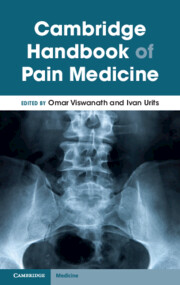Book contents
- Cambridge Handbook of Pain Medicine
- Cambridge Handbook of Pain Medicine
- Copyright page
- Contents
- Contributors
- Pain Handbook Introduction
- Part I Introduction to Pain: Pain Signaling Pathways
- Part II Common Categories of Pharmacologic Medications to Treat Chronic Pain
- Part III Chronic Pain Conditions Head and Neck
- Part IV Spine
- Chapter 15 Chronic Neuraxial Spine Pain
- Chapter 16 Vertebral Compression Fractures
- Chapter 17 Sacral Insufficiency Fractures
- Part V Extremities
- Part VI Misc
- Part VII Adjunctive Therapy
- Index
- References
Chapter 17 - Sacral Insufficiency Fractures
from Part IV - Spine
Published online by Cambridge University Press: 01 December 2023
- Cambridge Handbook of Pain Medicine
- Cambridge Handbook of Pain Medicine
- Copyright page
- Contents
- Contributors
- Pain Handbook Introduction
- Part I Introduction to Pain: Pain Signaling Pathways
- Part II Common Categories of Pharmacologic Medications to Treat Chronic Pain
- Part III Chronic Pain Conditions Head and Neck
- Part IV Spine
- Chapter 15 Chronic Neuraxial Spine Pain
- Chapter 16 Vertebral Compression Fractures
- Chapter 17 Sacral Insufficiency Fractures
- Part V Extremities
- Part VI Misc
- Part VII Adjunctive Therapy
- Index
- References
Summary
Sacral insufficiency fracture (SIF) is not uncommon, especially in the elderly, and is associated with a significant decrease in quality of life. SIF is most frequently found in patients with sacroiliac joint pathology in the setting of a sacrum compromised due to conditions such as osteoporosis, rheumatoid arthritis, or radiation therapy. Nonspecific symptoms of SIF make diagnosis challenging. MRI is the gold standard for diagnosis of SIF. Traditional therapies revolved around conservative measures such as bed rest, physical therapy, and analgesia. Conservative management is safe; minimally invasive treatments such as sacroplasty may provide improved short- and long-term relief. Surgical management with screw fixation is a viable option for qualifying patients and can be offered in conjunction with cement augmentation.
- Type
- Chapter
- Information
- Cambridge Handbook of Pain Medicine , pp. 119 - 130Publisher: Cambridge University PressPrint publication year: 2023



